Courbevoie
Courbevoie (French pronunciation: [kuʁ.bə.vwa]) is a commune located in the Hauts-de-Seine Department of the Île-de-France region of France. It is in the suburbs of the city of Paris, 8.2 km (5.1 mi) from the center of Paris. The centre of Courbevoie is situated 2 kilometres from the city limits of Paris.
Courbevoie | |
|---|---|
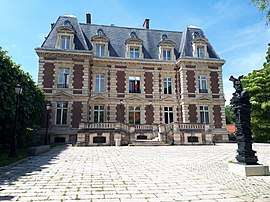 Courbevoie Municipal Library | |
 Coat of arms | |
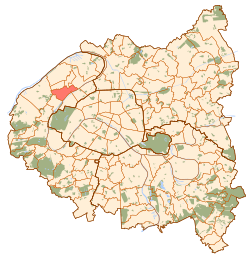 Paris and inner ring départements | |
Location of Courbevoie 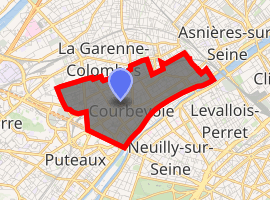
| |
 Courbevoie Paris and inner ring départements 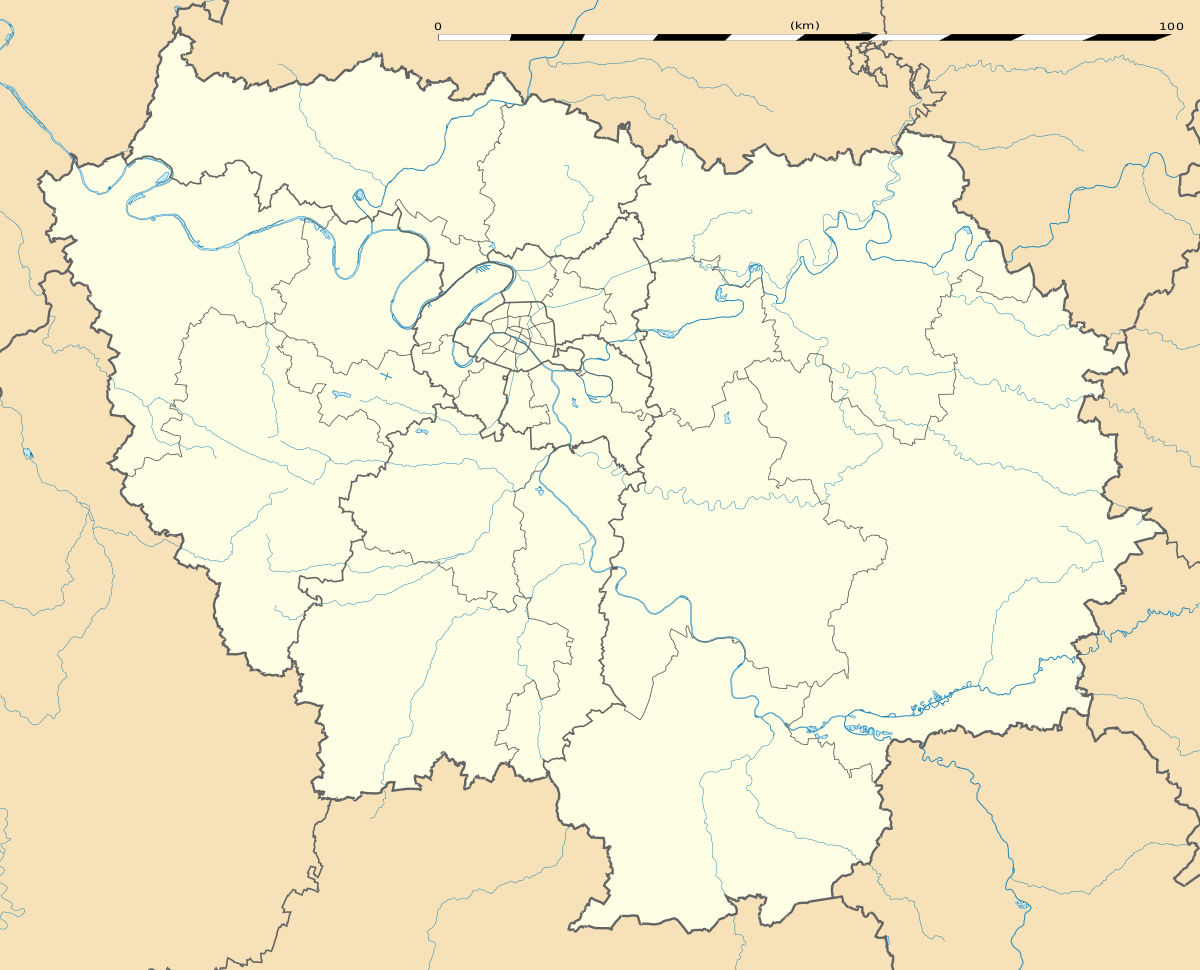 Courbevoie Courbevoie (Île-de-France (region)) | |
| Coordinates: 48°53′52″N 2°15′11″E | |
| Country | France |
| Region | Île-de-France |
| Department | Hauts-de-Seine |
| Arrondissement | Nanterre |
| Canton | Courbevoie-1 and 2 |
| Intercommunality | Grand Paris |
| Government | |
| • Mayor (2014–2020) | Jacques Kossowski |
| Area 1 | 4.17 km2 (1.61 sq mi) |
| Population (2017-01-01)[1] | 81,719 |
| • Density | 20,000/km2 (51,000/sq mi) |
| Time zone | UTC+01:00 (CET) |
| • Summer (DST) | UTC+02:00 (CEST) |
| INSEE/Postal code | 92026 /92400 |
| Elevation | 25–56 m (82–184 ft) |
| 1 French Land Register data, which excludes lakes, ponds, glaciers > 1 km2 (0.386 sq mi or 247 acres) and river estuaries. | |
La Défense, a business district hosting the tallest buildings in the metropolitan area, spreads over the southern part of Courbevoie (as well as parts of Puteaux and Nanterre).
Name
The name Courbevoie comes from Latin Curva Via and means "curved highway", allegedly in reference to a Roman road from Paris to Normandy which made a sharp turn to climb the hill over which Courbevoie was built.
Administration
Courbevoie is divided into two cantons: Canton of Courbevoie-1 and Canton of Courbevoie-2.
History
A wooden bridge was built crossing the Seine at Courbevoie by order of King Henry IV when in 1606 his royal coach fell into the river while being transported by ferry. Rebuilt in stone during the eighteenth century, this was replaced by a metal bridge in 1946.
The Convent of the Penitents founded in 1658 by Jean-Baptiste Forne was located in Courbevoie until the Revolution of 1789. Also located in the town was the barracks of the Swiss Guard of the monarchy.
Transport
Courbevoie is served by two stations on the Transilien Paris – Saint-Lazare suburban rail line: Courbevoie and Bécon-les-Bruyères. Courbevoie is also served by Esplanade de La Défense station on Paris Métro Line 1, in the business district of La Défense.
There are also a large number of city buses that come through the bustling La Défense station.
When it comes to air transportation, Courbevoie can be served by Paris's Charles de Gaulle Airport as well as Paris-Orly to the south and Beauvais Airport to the north.
Education
Courbevoie has multiple preschools and elementary schools. Junior high schools include:[2]
- Collège Alfred de Vigny
- Collège Georges Pompidou
- Collège Georges Seurat
- Collège Les Bruyères
- Collège Les Renardières
- Collège Sainte Geneviève
Senior high schools include:
Notable people
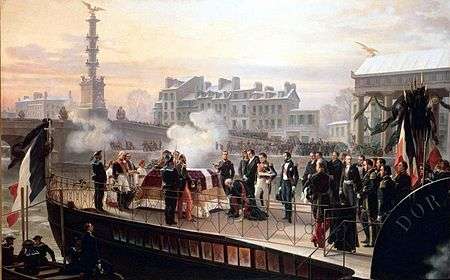
- Arletty, actress and singer
- Axel Augis, gymnast
- Henri Betti, composer
- Michel Delpech, singer
- Louis de Funès, comedy actor
- Colomba Fofana, athlete
- Albert Gleizes, cubist artist, painter, theorist
- Madeleine Kamman, cook, culinary teacher, and author
- Lamine Kante, basketball player
- Massire Kante, footballer
- Georges Lamothe (1842–1894), composer, pianist and organist
- Henri Letocart (1866–1945), organist and composer
- Marie-Bernadette Mbuyamba, basketball player
- William Remy, footballer
- Franck Tchiloemba, basketball player
- Yoann Wachter, footballer
- Michel Blanc, actor
- Louis-Ferdinand Céline, writer
- Hélène de Krzyżanowska-Dyhrn, pianist and relative of Chopin
- Jean-Pierre Worms, representative to the French Parliament
- Stephane Coquin, footballer
- Roy Benson, stage magician
International relations
Courbevoie is twinned with:



Mayors of Courbevoie
- Antoine Le Frique (1800–1818)
- Joseph Derbanne (October, 1818 – February, 1826)
- Nicolas Rousselot (February 1826 – April 1830)
- Jean-Baptiste Chevalier (April 1830 – August 1830)
- Constant Grebaut (August 1830 – September 1840)
- Désiré Maurenq (September 1840 – 1845)
- Constant Grebaut (1845 – 26 August 1865)
- Charles Blondel (26 August 1865 – 7 February 1872)
- Jean-François Durenne (7 February 1872 – November 1873)
- Jean-Baptiste Weiss (November 1873 – 20 February 1874)
- Auguste Colas (20 February 1874 – 12 February 1878)
- Frédéric Bourgin (12 February 1878 – October 1878)
- Auguste Bailly (October 1878 – 19 May 1888)
- Antoine Rolland (19 May 1888 – 15 May 1892)
- Jules Lefevre (15 May 1892 – 27 January 1894)
- François le Chippey (27 January 1894 – May 1896)
- Léon Boursier (May 1896 – May 1908)
- Charles Mering (May 1908 – December 1919)
- Augustin Loiseau (December 1919 – October 1920)
- Joseph Victor (October 1920 – May 1925)
- Pierre Fouquart (May 1925 – September 1927)
- André Grisoni (September 1927 – July 1944)
- Gabriel Roche (September 1944 – 26 October 1947)
- Marius Guerre (26 October 1947 – 20 December 1954)
- Gabriel Roche (26 January 1955 – 15 March 1959)
- Charles Deprez (26 March 1959 – 18 June 1995)
- Jacques Kossowski (since 25 June 1995)
Demographics
Immigration
| Born in Metropolitan France | Born outside Metropolitan France | |||
|---|---|---|---|---|
| 80.0% | 20.0% | |||
| Born in Overseas France |
Born in foreign countries with French citizenship at birth1 | EU-15 immigrants2 | Non-EU-15 immigrants | |
| 1.1% | 3.8% | 3.4% | 11.7% | |
| 1 This group is made up largely of former French settlers, such as pieds-noirs in Northwest Africa, followed by former colonial citizens who had French citizenship at birth (such as was often the case for the native elite in French colonies), and to a lesser extent foreign-born children of French expatriates. Note that a foreign country is understood as a country not part of France in 1999, so a person born for example in 1950 in Algeria, when Algeria was an integral part of France, is nonetheless listed as a person born in a foreign country in French statistics. 2 An immigrant is a person born in a foreign country not having French citizenship at birth. Note that an immigrant may have acquired French citizenship since moving to France, but is still considered an immigrant in French statistics. On the other hand, persons born in France with foreign citizenship (the children of immigrants) are not listed as immigrants. | ||||
Economy
Total S.A. has its head office in the Tour Total in La Défense and in Courbevoie.[7] Areva has its head office in the Tour Areva in Courbevoie.[8] Saint-Gobain also has its head office in Courbevoie.[9]
The headquarters of INPI, the French government office for patents, copyrights, and trademarks, is in Courbevoie.[10]
Gallery
- Street at the border between Courbevoie and Asnières
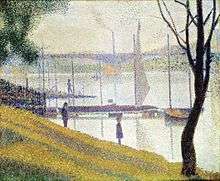 Bridge of Courbevoie, Georges Seurat, 1886–1887
Bridge of Courbevoie, Georges Seurat, 1886–1887
See also
- La Défense business district.
- List of tallest structures in Paris
- Phare Tower, a 300-meter skyscraper now under construction
- Communes of the Hauts-de-Seine department
References
- "Populations légales 2017". INSEE. Retrieved 6 January 2020.
- "Annuaire des établissements / équipements ." Ville de Courbevoie. Retrieved on February 25, 2017.
- "Accueil." Lycée Paul Lapie de Courbevoie. Retrieved on June 21, 2015.
- "Accueil." Lycée Paul Painlevé Courbevoie. Retrieved on June 21, 2015.
- "Accueil Archived 2015-06-21 at the Wayback Machine." Collège Les renardières et Lycée Lucie Aubrac. Retrieved on June 21, 2015.
- "Accueil Archived 2015-06-21 at the Wayback Machine." Groupe scolaire Montalembert. Retrieved on June 21, 2015.
- "Total: Main indicators." Reuters. Thursday October 15, 2009. Retrieved on October 19, 2009.
- "Legal Notice." Areva. Retrieved on 21 June 2010.
- "Legal notice." Saint-Gobain. Retrieved on 7 July 2010.
- Contact us, at INPI official web site
External links
| Wikimedia Commons has media related to Courbevoie. |
- Courbevoie official website (in French)
- Courbevoie Community portal (in French)
- blog about Courbevoie (in French)